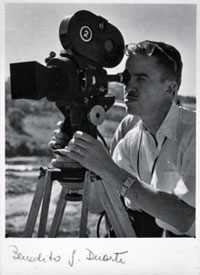TRIBUTE TO BENEDITO JUNQUEIRA DUARTE
 The critic Francisco Luiz de Almeida Salles, one of the
essential personalities of film in São Paulo in the last
century, wrote in a preface that Benedito Junqueira
Duarte “combined respect with truth, with the cult
of indignation.” The first guaranteed a place in Brazilian
cinema for Duarte; the second has unfairly
deprived him from this history. The photographer,
filmmaker, and critic B.J. Duarte, as he preferred to
be known, loved cinema but looked down on the
chanchadas and detested Cinema Novo. He admired
Vera Cruz but loathed Lima Barreto, the director
of the São Paulo studio’s greatest success, “Cangaceiro.”
He fought intensely for the development
of Brazilian cinema but didn’t hesitate to recognize
that it was “so full of charlatans.” It is not surprising,
therefore, that silence has formed around this
figure just fifteen years after his death. His centennial
birthday next July comes as an opportune invitation
to re-examine his work. This homage from
It’s All True only intends to accelerate this process,
following the pioneering movement started doubly
by the Secretaria Municipal da Cultura de São Paulo
(Carlos Augusto Calil administration) two years ago
in partnership with the Cinemateca Brasileira to restore
some of Duarte’s short documentaries about
the São Paulo capital, and the publication of a book
with Cosac Naify of a dazzling volume of Duarte’s
photography titled “Image Hunter.”
The critic Francisco Luiz de Almeida Salles, one of the
essential personalities of film in São Paulo in the last
century, wrote in a preface that Benedito Junqueira
Duarte “combined respect with truth, with the cult
of indignation.” The first guaranteed a place in Brazilian
cinema for Duarte; the second has unfairly
deprived him from this history. The photographer,
filmmaker, and critic B.J. Duarte, as he preferred to
be known, loved cinema but looked down on the
chanchadas and detested Cinema Novo. He admired
Vera Cruz but loathed Lima Barreto, the director
of the São Paulo studio’s greatest success, “Cangaceiro.”
He fought intensely for the development
of Brazilian cinema but didn’t hesitate to recognize
that it was “so full of charlatans.” It is not surprising,
therefore, that silence has formed around this
figure just fifteen years after his death. His centennial
birthday next July comes as an opportune invitation
to re-examine his work. This homage from
It’s All True only intends to accelerate this process,
following the pioneering movement started doubly
by the Secretaria Municipal da Cultura de São Paulo
(Carlos Augusto Calil administration) two years ago
in partnership with the Cinemateca Brasileira to restore
some of Duarte’s short documentaries about
the São Paulo capital, and the publication of a book
with Cosac Naify of a dazzling volume of Duarte’s
photography titled “Image Hunter.”
Fair enough. It was working for the then newly-born
cultural sector of the São Paulo administration
that, starting in the mid-1930s, Duarte developed
his photo-documentary talent, previously applied
to work as a portrait-maker of the bourgeoisie and
photographic reporter, and expanded it to filmmaking.
The invitation for hiring him came from (of
course) Mário de Andrade.
“In his photography,” wrote critic Rubens Fernandes
Junior, “nothing is superfluous, nothing is accidental
- on the contrary - everything is deliberate and
aware, the result of specialized technical training
and broad and sophisticated cultural training.” The
same can be said of his cinema.
B.J. Duarte’s documentary filmography is divided
in two moments, with evident coherence between
the two. The first part, which is essential to this
homage, focuses on the rapid expansion of São
Paulo from quiet city to chaotic metropolis. Like
in the first Joris Ivens, the photographic images
gain movement, fascinated by the new forms and
rhythms. They were, in the words of Duarte himself:
“shy and in need of more ambitious intentions but,
in any case, acknowledged painterly aspects of São
Paulo.”
Parallel to Humberto Mauro joining the Instituto
Nacional do Cinema Educativo, this first stage of
informative short documentaries was surpassed
by Duarte’s growing specialization in scientific and
medical documentaries, of which he became the
most expressive Brazilian specialist. Among more
than 150 of his films, constantly awarded abroad,
none is more important than the one that was shot
in May 1968, in which he documented (next to Estanislau
Szankóvsk) the first heart transplant made
in South America, under the coordination of Dr. Euryclides
de Jesus Zerbini.
“There are didactic films that are pure art, pure poetry
(like some by Jean Painlevé, for example), and
highly didactic artistic films, like those by Robert
Flaherty,” Duarte affirmatively summarized in an
interview. In his untiring search for images, Benedito
Junqueira Duarte often reached his ideal - and,
generously, battled like few others to preserve everyone’s
images in the front line of founding the Foto
Clube Bandeirante and the Cinemateca Brasileira.
Writing about the journalist, critic and memorialist
Paulo Duarte (1899-1984), Benedito’s older brother,
Antonio Candido highlighted how “in 1922, Paulo
Duarte was literally conservative, though culturally
renewing.” If we exchange literature for the cinematographer
and advance history’s clock a little, the
formula fits the younger Duarte well. It’s about time
to (re)acknowledge him more.
Amir Labaki
Filmes da Mostra
|




